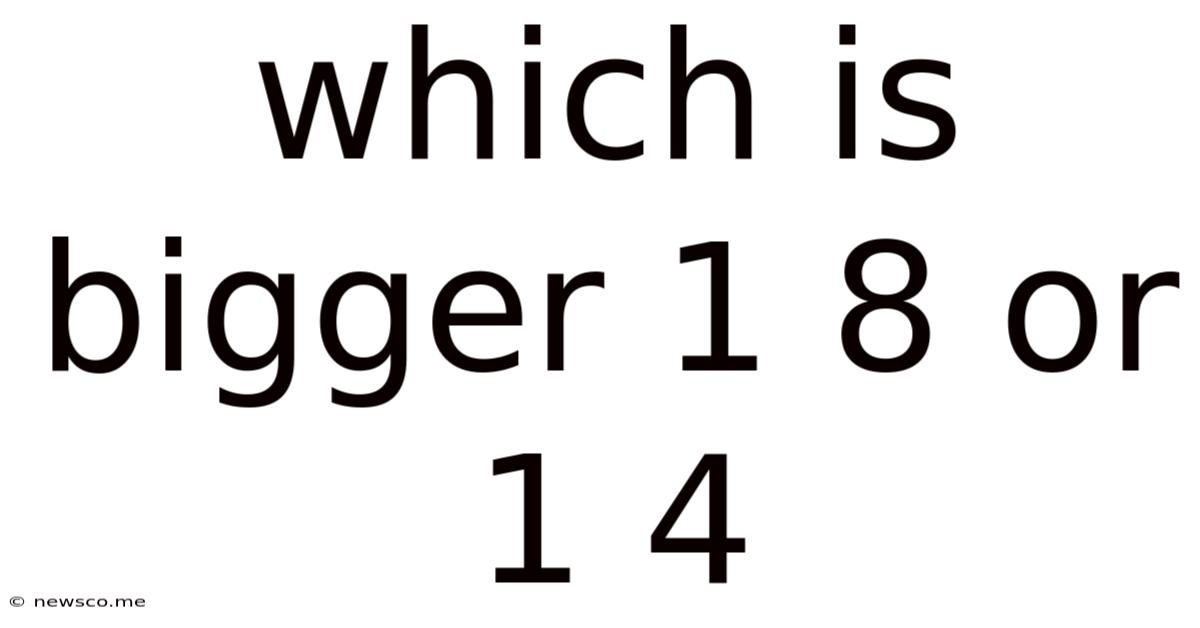Which Is Bigger 1 8 Or 1 4
News Co
Apr 20, 2025 · 4 min read

Table of Contents
Which is Bigger: 1/8 or 1/4? A Comprehensive Comparison
Understanding fractions is a fundamental skill in mathematics, crucial for various applications in everyday life and advanced studies. This article will delve deep into the comparison of two common fractions: 1/8 and 1/4, clarifying which is bigger and explaining the underlying concepts using multiple approaches. We will explore different methods for comparing fractions, reinforcing the learning process and building a strong foundation in fractional arithmetic.
Visualizing the Fractions: A Pictorial Approach
One of the easiest ways to understand which fraction is larger is through visualization. Imagine a pizza cut into eight equal slices (representing 1/8) and another pizza cut into four equal slices (representing 1/4).
The Pizza Analogy
-
1/4 (One-quarter): If you take one slice from the pizza cut into four, you have a significantly larger portion than if you take one slice from the pizza cut into eight.
-
1/8 (One-eighth): A single slice from the pizza divided into eight is considerably smaller.
This simple analogy visually demonstrates that 1/4 is larger than 1/8.
Comparing Denominators: The Key to Understanding
The denominator of a fraction (the bottom number) indicates the total number of equal parts a whole is divided into. The numerator (the top number) shows how many of those parts we are considering.
In our case:
- 1/4: The denominator is 4, meaning the whole is divided into four equal parts.
- 1/8: The denominator is 8, meaning the whole is divided into eight equal parts.
The larger the denominator, the smaller each individual part becomes. Since 8 is larger than 4, each piece in the 1/8 fraction is smaller than each piece in the 1/4 fraction. Therefore, 1/4 is larger than 1/8.
Converting to Decimals: A Numerical Approach
Converting fractions to decimals provides another way to compare their values.
-
1/4: To convert 1/4 to a decimal, divide the numerator (1) by the denominator (4): 1 ÷ 4 = 0.25
-
1/8: To convert 1/8 to a decimal, divide the numerator (1) by the denominator (8): 1 ÷ 8 = 0.125
By comparing the decimal values, we see that 0.25 (1/4) is greater than 0.125 (1/8). This confirms our previous findings.
Finding a Common Denominator: A Mathematical Method
A more formal method involves finding a common denominator. This allows for direct comparison of the numerators. The least common multiple (LCM) of 4 and 8 is 8.
-
1/4: To obtain a denominator of 8, we multiply both the numerator and denominator by 2: (1 x 2) / (4 x 2) = 2/8
-
1/8: This fraction already has a denominator of 8.
Now, we can easily compare the fractions: 2/8 is greater than 1/8. This once again proves that 1/4 is larger than 1/8.
Real-World Applications: Understanding Fractions in Daily Life
Understanding the difference between 1/8 and 1/4 has practical applications in various real-world scenarios:
Cooking and Baking:
Recipes often call for fractional measurements. Knowing which fraction is larger ensures accurate ingredient proportions, leading to better results. For instance, using 1/4 cup of sugar instead of 1/8 cup will result in a noticeably sweeter product.
Measurement and Construction:
In construction or engineering, precise measurements are critical. Understanding fractions is essential for accurate calculations and avoiding errors that could compromise structural integrity.
Finance and Budgeting:
Fractions are used extensively in financial calculations. Understanding the relative sizes of fractions helps in managing budgets, calculating interest rates, and interpreting financial reports.
Extending the Concept: Comparing Other Fractions
The methods discussed above can be applied to compare other fractions. The key is to understand the relationship between the numerator and the denominator and to use appropriate methods like finding a common denominator or converting to decimals for comparison.
Conclusion: 1/4 is Larger than 1/8
Through visual representation, decimal conversion, finding a common denominator, and real-world examples, we have conclusively shown that 1/4 is larger than 1/8. Understanding this fundamental concept is crucial for building a strong mathematical foundation and for applying fractional arithmetic in various practical situations. Mastering this concept lays the groundwork for tackling more complex fractional operations and problem-solving. Remember to practice these techniques with different fractions to strengthen your understanding and develop proficiency.
Latest Posts
Related Post
Thank you for visiting our website which covers about Which Is Bigger 1 8 Or 1 4 . We hope the information provided has been useful to you. Feel free to contact us if you have any questions or need further assistance. See you next time and don't miss to bookmark.